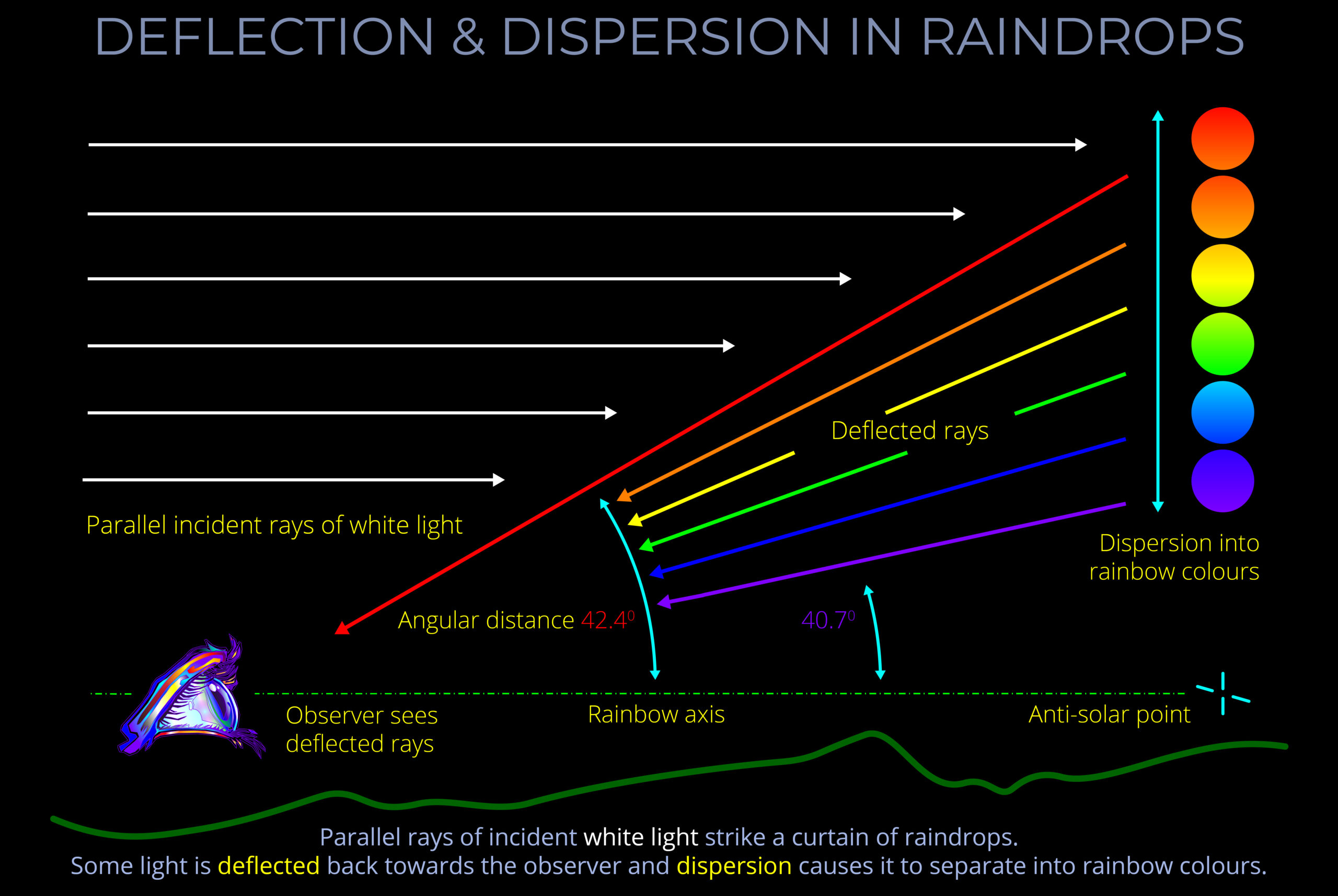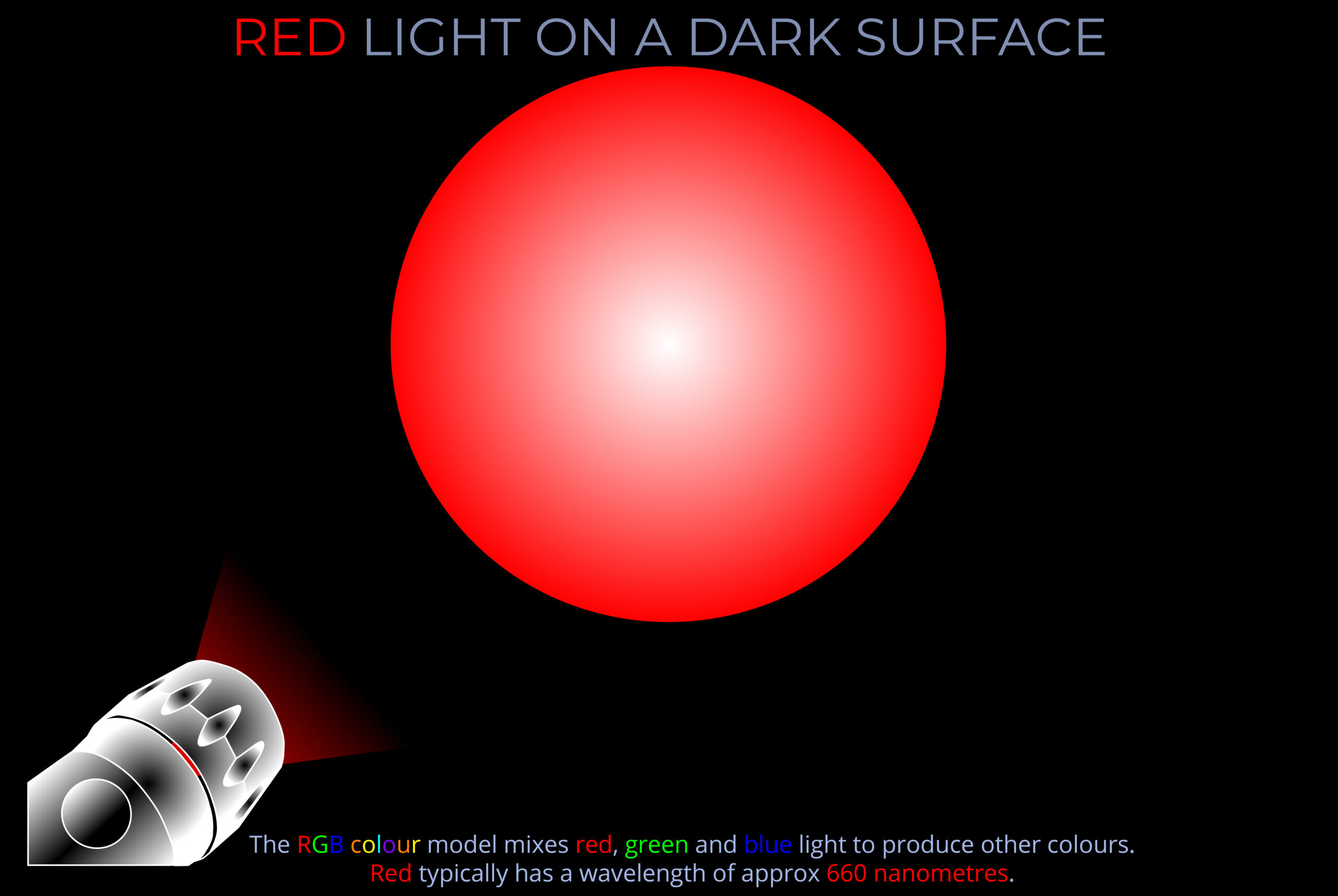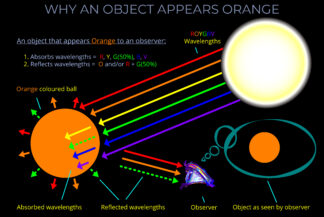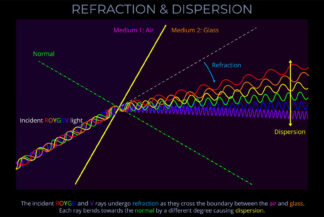Deflection & Dispersion in Raindrops
£0.00
This is one of a set of almost 40 diagrams exploring Rainbows.
Each diagram appears on a separate page and is supported by a full explanation.
- Follow the links embedded in the text for definitions of all the key terms.
- For quick reference don’t miss the summaries of key terms further down each page.
Description
Deflection & Dispersion in Raindrops
TRY SOME QUICK QUESTIONS AND ANSWERS TO GET STARTED
About the diagram
An overview of raindrops
Overview of diagram
- Rainbows form when sunlight encounters a curtain of rain.
- The sunlight enters raindrops at one point and then emerges at another.
- Each raindrop is made of liquid water and acts as a tiny prism.
- Between the point of entry and the point of exit, light undergoes refraction, reflection and dispersion.
- The angles of refraction and reflection are the main determinants of the angle of deflection.
- Refraction also causes dispersion, separating sunlight into rainbow (spectral) colours.
- The visible spectrum is composed of wavelengths between approximately 380 and 740 nanometres and each corresponds with a different colour.
- Although we recognise the rainbow colours ROYGBV (red, orange, yellow, green, blue and violet) each and every wavelength produces a slightly different colour.
- Each droplet of rain can only direct one colour towards an observer’s eyes at one time. The apparent colour changes from red through to violet as it falls towards the ground.
- Only rays that strike a raindrop at a tangent to the arcs of a rainbow and exactly intersect it are reflected towards an observer. Rays that strike to the left or right-hand side miss the observer.
About the diagram
- This diagram shows an observer looking up towards droplets of rain as parallel rays of white light from the Sun are deflected back towards them.
- The diagram is in cross-section so the Sun, the eye of an observer, the anti-solar point ( the centre of the rainbow) are all shown along their shared axis.
- The observer sees coloured droplets at different elevations with red at the top and violet at the bottom.
- Raindrops that are at an angular distance of a little more than 42.40 deflect infra-red light which is invisible to an observer.
- As raindrops pass an elevation of 42.40 from the axis they appear red. As they continue to fall each one changes colour, first to orange then yellow, green, blue and finally at 40.70 to violet.
- At an angular distance of a little less than 40.70 raindrops deflect ultra-violet light which is invisible to an observer.
- Each colour of visible light corresponds with a different wavelength but instead of seeing a smooth and continuous range of colours an observer sees distinct bands of colour.
- The fact that we see a few distinct bands of colour in a rainbow, rather than a smooth and continuous gradient of hues, is sometimes described as an artefact of human colour vision.
Rainbows are reflections of the Sun
Some key terms
The angle of refraction measures the angle to which light bends as it passes across the boundary between different media.
- The angle of refraction is measured between a ray of light and an imaginary line called the normal.
- In optics, the normal is a line drawn on a ray diagram perpendicular to, so at a right angle to (900), the boundary between two media.
- See this diagram for an explanation: Refraction of a ray of light
- If the boundary between the media is curved, the normal is drawn perpendicular to the boundary.
In the field of optics, dispersion is shorthand for chromatic dispersion which refers to the way that light, under certain conditions, separates into its component wavelengths, enabling the colours corresponding with each wavelength to become visible to a human observer.
- Chromatic dispersion refers to the dispersion of light according to its wavelength or colour.
- Chromatic dispersion is the result of the relationship between wavelength and refractive index.
- When light travels from one medium (such as air) to another (such as glass or water) each wavelength is refracted differently, causing the separation of white light into its constituent colours.
- When light undergoes refraction each wavelength changes direction by a different amount. In the case of white light, the separate wavelengths fan out into distinct bands of colour with red on one side and violet on the other.
- Familiar examples of chromatic dispersion are when white light strikes a prism or raindrops and a rainbow of colours becomes visible to an observer.
Incident light refers to light that is travelling towards an object or medium.
- Incident light refers to light that is travelling towards an object or medium.
- Incident light may come from the Sun, an artificial source or may have already been reflected off another surface, such as a mirror.
- When incident light strikes a surface or object, it may be absorbed, reflected, refracted, transmitted or undergo any combination of these optical effects.
- Incident light is typically represented on a ray diagram as a straight line with an arrow to indicate its direction of propagation.
The spectral colour model represents the range of pure colours that correspond to specific wavelengths of visible light. These colours are called spectral colours because they are not created by mixing other colours but are produced by a single wavelength of light. This model is important because it directly reflects how human vision perceives light that comes from natural sources, like sunlight, which contains a range of wavelengths.
- The spectral colour model is typically represented as a continuous strip, with red at one end (longest wavelength) and violet at the other (shortest wavelength).
- Wavelengths and Colour Perception: In the spectral colour model, each wavelength corresponds to a distinct colour, ranging from red (with the longest wavelength, around 700 nanometres) to violet (with the shortest wavelength, around 400 nanometres). The human eye perceives these colours as pure because they are not the result of mixing other wavelengths.
- Pure Colours: Spectral colours are considered “pure” because they are made up of only one wavelength. This is in contrast to colours produced by mixing light (like in the RGB colour model) or pigments (in the CMY model), where a combination of wavelengths leads to different colours.
- Applications: The spectral colour model is useful in understanding natural light phenomena like rainbows, where each visible colour represents a different part of the light spectrum. It is also applied in fields like optics to describe how the eye responds to light in a precise, measurable way.
The angle of incidence measures the angle at which incoming light strikes a surface.
- The angle of incidence is measured between a ray of incoming light and an imaginary line called the normal.
- See this diagram for an explanation: Reflection of a ray of light
- In optics, the normal is a line drawn on a ray diagram perpendicular to, so at a right angle to (900), the boundary between two media.
- If the boundary between the media is curved, then the normal is drawn at a tangent to the boundary.
The angle of reflection measures the angle at which reflected light bounces off a surface.
- The angle of reflection is measured between a ray of light which has been reflected off a surface and an imaginary line called the normal.
- See this diagram for an explanation: Reflection of a ray of light
- In optics, the normal is a line drawn on a ray diagram perpendicular to, so at a right angle to (900), the boundary between two media.
- If the boundary between the media is curved then the normal is drawn perpendicular to the boundary.
On a sunny day, if you stand with the Sun at your back and look at the ground, the shadow of your head will align with the antisolar point.
- The antisolar point is the position directly opposite the Sun, around which the arcs of a rainbow appear. An imaginary straight line can always be drawn that passes through the Sun, the eyes of an observer, and the antisolar point, which is the geometric centre of a rainbow.
- This concept corresponds with what an observer sees in real life: the idea that a rainbow has a center. From a side view, the centre of a rainbow is called the antisolar point, so named because it is opposite the Sun relative to the observer’s position.
- Unless observed from the air, the antisolar point is always below the horizon. Both primary and secondary rainbows share the same antisolar point, as do higher-order bows, such as fifth and sixth-order rainbows.



